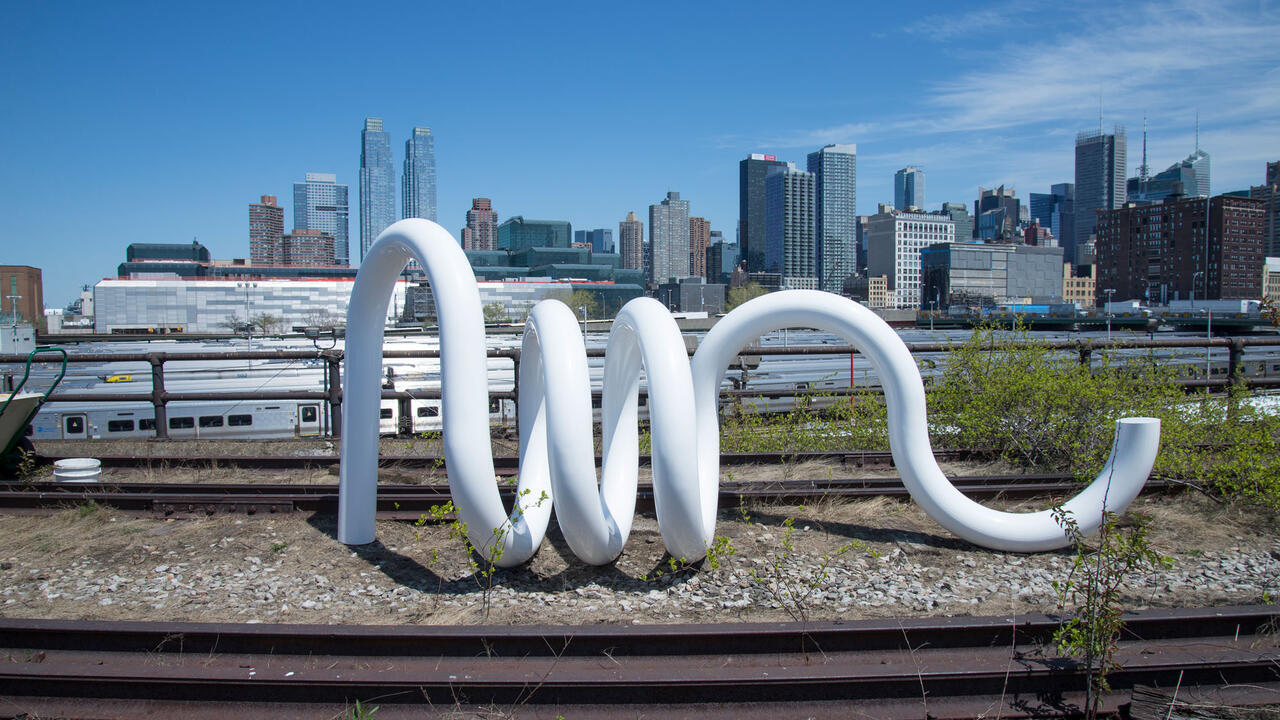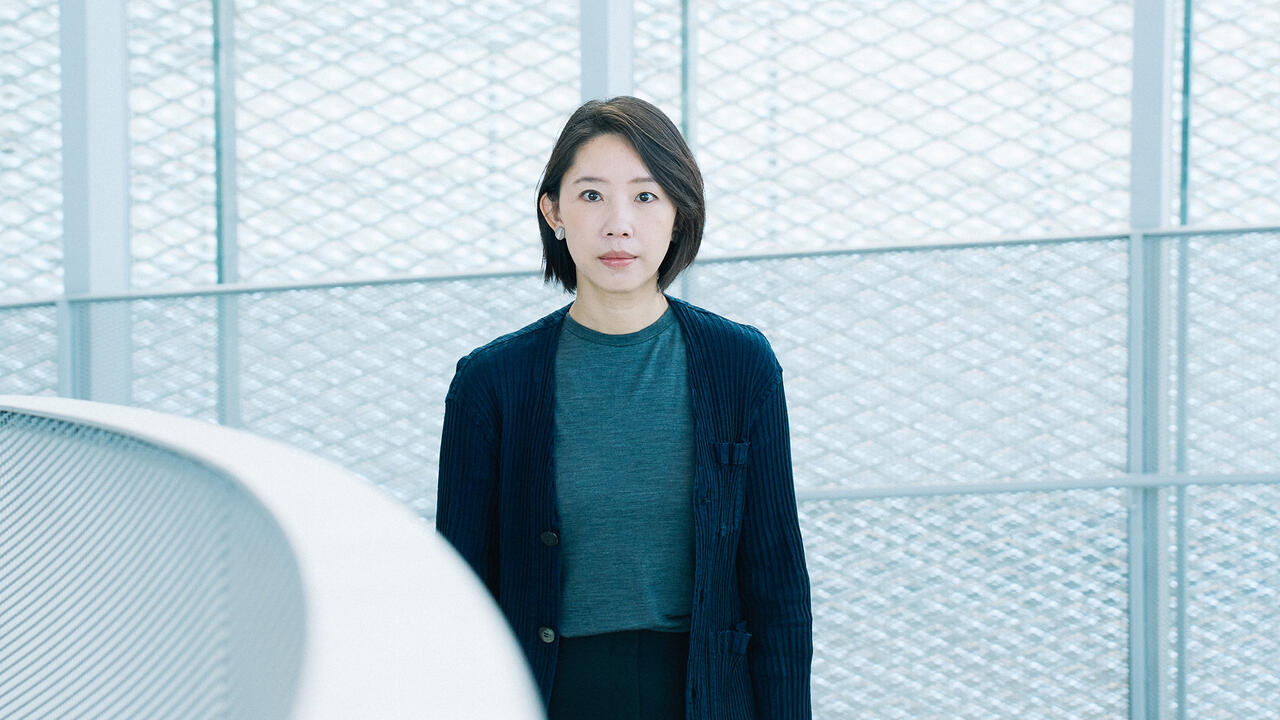Room to Live
The Berlin-based artist discusses her Iranian-Armenian background; political art; and her current exhibition with sculptor Phyllida Barlow
The Berlin-based artist discusses her Iranian-Armenian background; political art; and her current exhibition with sculptor Phyllida Barlow

JÖRG HEISER In ‘Butcher, Barber, Angler & Others’ (2009), the constellation of sculptures you recently showed at Studio Voltaire in London, delicate materializations of the titles (a salon hairdryer, salami, fishing rod) flow into one another, surrounded by stylized wastepaper baskets (Bins for Rejected Plans, 2009) and objects that look like distorted bus-stop seats (Others, 2009). There’s something very surreal about all of this, even though the piece alludes to the very practical skills – the craft – of butchers and barbers. What concept of craft did you have in mind?
NAIRY BAGHRAMIAN It began with an understanding that a sculptural form cannot simply be split into a conceptual component and a material or psychic ‘remnant’. But I have no wish to control whether the connections made by viewers suggest otherwise. That was, perhaps, one idea behind the rubbish bins: to have a place within the exhibition for ‘remnants’.
JH But, besides the craft of shaping sculptures, didn’t the exhibition also demonstrate an interest in craft per se?
NB My primary focus was not on workmanship in regard to materials, but on the identity-shaping role of one’s occupation: is it about being productive for society, or about leisure?
JH So what happens if one’s professional identity becomes unclear?
NB When I was in London, I recalled Marx and Engels’ Utopian idea that one could be a craftsman in the morning and a poet at night [The German Ideology, 1845]. But capitalism has long since taken on board the idea that one can switch swiftly between different occupations, and has abused it by turning it into a compulsion. Although being flexible still appears as a promise of self-fulfilment, it is often involuntary and largely determined by economic imperatives.

JH The sketches for your Studio Voltaire installation remind me of the playful quality of Alexander Calder’s mobiles – a lightness is present in the actual sculptures, but it’s frozen.
NB It’s about capturing the moment, whilst alluding to the idea of escape.
JH Are you interested in Minimalist doctrines, such as the idea that the artist’s subjectivity plays no part in the object’s relationship with the space and the viewer?
NB When Donald Judd writes about the colour red he refers to how colour changes according to context. I was struck by the way that his apparent belief in the object or material as free of other levels of meaning doesn’t survive in his theoretical writing – for example, in his 1983 essay ‘Art and Architecture’. Stephen Prina has found an answer to this: in one exhibition, he noticed that a Dan Flavin sculpture served as the source of light for a work by Judd. Prina photographically documented it, and this work, in turn, is only allowed to be lit by a Flavin sculpture (A Photograph, 1992). So yes, the displacements and contradictions of Minimalism have had an impact on me.
JH Some younger artists – such as Ei Arakawa or Nora Schultz – stage the instalment of post-Minimalist objects as performative events. These gestures are supposed to remain somehow modest and anti-confessional, but ultimately, by being announced as ‘events’, run the risk of slipping into an over-glorification of the artist’s gestural sensibility. This doesn’t occur in your work; although your interest in interior design would suggest a staging of the physical usage of objects in the context of your installations.
NB That is simply not my concern. I’m interested in the political implications of interior design; namely, why certain designers – mainly women and gay men – withdrew so markedly from the public realm of architecture or urban planning to concentrate on the domestic sphere. It is here that they engaged with objects. Maybe this too, is part of the Minimalist idea: exhausting the possibilities of the object.
JH But the perceived effeminacy attributed to interiors amounts to a stigmatization of interior design.
NB Historically, access to the public sphere has been denied to women and gay men in numerous ways, whether they were not allowed to vote or had to hide their sexual orientation. So it’s important to discuss the politics of interior design. This is the difference between what I do and many works of recent years where artists create arranged spaces: I want to use my knowledge not to practice interior design myself, but to highlight its resonances with the ‘outside world’ – the public, political sphere. Many shows of interior design and objects promise a retreat, a kind of inwardness.
JH Your installations, on the other hand, create transitory spaces. Works like Türsteher (Bouncer, 2008), in which a sheet of aluminium and a sheet of rubber are bent into a doorway like an arch, or Spanner (Stretcher-Loiterer, 2008), a long chrome-plated brass pipe jammed horizontally between two walls, generate tension at the limits of the room. The question of inside and outside is not one of either/or.
NB During the preparations for my exhibition at Kunsthalle Basel in 2006, I overheard Gustav Metzger, who had a show there before me, saying: ‘It’s funny, if this wall didn’t exist, then the space could have been built by Albert Speer.’ This idea of imagining-away an element, thus completely changing the environment, inspired the installation Das hübsche Eck (The Pretty Corner, 2006), which is set both in front of, and behind, a wall. It really only works if you can imagine the wall not being there.

JH In Halfway House (1999) these themes of architecture and borders are alluded to in a series of photographs taken at a women’s shelter in Berlin. How did you arrive at this subject matter?
NB At the time, there was a rather broad-brush approach to political art in Berlin that wished to replace art with displays of newspaper clippings and documentary photographs. It was always about immigrants, homeless people and marginal groups. This treatment of the complexity of political spaces was too simple. I’ve been working in a women’s shelter since I was 18 – the aim for the women is to dare to take the next step, to go back outside again. The protective space of the shelter is meant to be temporary. In contrast, I found it wrong when focusing attention on these themes to create a further protective space – but one that is restrictive. At the same time, when one speaks continuously as an artist about or for others, one is not least concerned with confirming one’s own authorial position. I tried to take a more abstract approach: for the staged photographs I installed telephone booths in the shelter. I tried to make apparent the tension between the need for a private refuge and the need to communicate with the outside world that is characteristic for a transitory protective space like the women’s shelter.
JH In discussions of the political in art, two objections are often raised: art is suspected of being decadent, and political activism is suspected of being puritanical. Your work is quite different. Can you describe the point when you realized that this is a false opposition?
NB For me, to reject any kind of art in pictorial or sculptural form and consider social or political activity as a substitute for art is a real problem. Where do art and political engagement overlap, and what form should this take? I have to make sure I reflect on my own role here, without exploiting myself.
JH But you do credit your art work with a political dimension?
NB Absolutely. Documentaries and direct speech and direct use of the body are not the only forms that communicate a political dimension.
JH In the 1990s, there was much talk of utilizing the political potential of identity for artistic production.
NB At that time, as a migrant with an Iranian-Armenian background, I was expected to transform the stigma associated with my status into something positive.
JH Later you made the photographic diptych New Waves (Am Kaspischen Meer) (On the Caspian Sea, 2003) where you play with this idea: you’re beside the Caspian Sea in Iran and you’re wearing a balaclava, with an Yves Saint Laurent tie whose label is revealed by a gust of wind.
NB That was a response to the way one is both stigmatized and how one uses oneself.
JH That was the only time you’ve worked with a self-portrait?
NB And a double portrait at that. Like twins. The movement between the two images is only noticeable because of the tie and the shifted gaze.
JH This representation of you sets off a reaction in most viewers’ minds: Iran, face covered, the veil, but also terrorism – and then there’s the tie, which is western, fashionable, male. Was the work one last comment on the aforementioned identity-based notions of political art you were confronted with in the 1990s?
NB Yes. I wanted to come to a conclusion; to tell myself that it was now dealt with, cut and dried.
JH And then there’s no need to do a work like this again?
NB No. At the same time, I think a new generation of artist immigrants, or whatever you want to call them, is now going in a different direction. I’m thinking of someone like Danh Vo.
JH What do you think has changed since the 1990s? That the ideal of transforming the ethnic stigma into something ‘positive’ has been abandoned? In Vo’s work, his Vietnamese roots are a theme, but at the same time it’s all about highlighting hybridity and interdependence between supposedly distinct regions and cultures. A clear attribution of identity becomes impossible.
NB In the 1990s one was expected to speak for many. I didn’t want that.
JH What is your position in the polarized debates about Islam – on the one hand, it’s denounced as a reactionary or even fascist ideology, and on the other, that cultural differences should be tolerated?
NB I reject any form of Islamization, although I do make compromises. I grew up in Iran – a country where Islam is not just a religion, but a government. The left-wing Turkish women’s movements of the 1970s, ’80s and ’90s in Berlin are now going to ruin because suddenly cultural identity is being defined in terms of religion. Migrants who live here and who have actually fought to free themselves of cultural and religious constraints are suddenly being told: ‘but it belongs to you, it’s part of your identity’.
JH Is this not a sensitive point that also concerns your work? Out of a justified interest in rejecting such attributions, does one run the risk of negating one’s own biography?
NB I negate the notion of art as a representation of one’s identity, but the issues are still present for me. The political content is not excluded from the object; I just reject a split between sculpture and purely declamatory political art. I do want other forms of political art to be possible, and I would like to work with them.
JH Your work Damenrad/Side Saddle (2009) – horizontal bar-like objects with added elements – is an ironic comment on traditional discussions of what is female and what is male sculpture.
NB I noticed that male artists show bicycles in galleries, cars in museums and aircraft at major biennials. I wanted to react to that. As an artist, there’s always an implicit claim that one is constantly reinventing the wheel. The work started with the question of what makes a bicycle a man’s bicycle: the crossbar. That was the idea – to take out the crossbar and reinvent it as ‘female’.
JH You’re doing a joint show with Phyllida Barlow at the Serpentine Gallery in London – what is the connection between your approaches to making sculpture?
NB What struck me about Phyllida’s work was that many of her objects are incredibly physical; they massively occupy the space. Initially, I was sceptical about this solid materiality but then it began to interest me, partly from the point of view of feminist issues. There were questions I had about the work of an artist like Franz West, too, but because I was repeatedly confronted with the actual objects themselves, I was able to answer them for myself. With Phyllida, it’s the other way round: many of her works have been destroyed; I have access to them only via illustrations. That’s what I found interesting: sculpture that is massive, but not present.
JH Pairing your work with Barlow’s was suggested by Hans Ulrich Obrist and Julia Peyton-Jones at the Serpentine Gallery.
NB Yes. And I think it’s a bold and interesting idea. The exhibition with Phyllida is not about contrasting a younger and an older position. Instead, it’s about a debate between different approaches to sculpture.
JH In your joint shows with Janette Laverrière – the 100-year-old pioneering Swiss designer who has been designing furniture since the 1920s – it never came across as if you were trying to feed off her aura, like so many artists whose work references different generation from art history. After all, she was largely unknown even to design experts.
NB I could just as easily have let Laverrière’s work flow into my own, without proposing a visible cooperation, so that she herself would not have featured at all. But I no longer have to prove that I can do it on my own.
The exhibition ‘Nairy Baghramian and Phyllida Barlow’ runs from 8 May – 13 June at the Serpentine Gallery, London, UK.
Translated from German by Nicholas Grindell






















